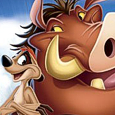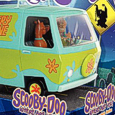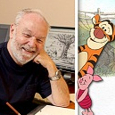DisneyToon Studios (1998, 2004), Walt Disney Home Entertainment (March 6 2012), 2 individual Blu-ray and DVD combo packs, 81 and 76 mins plus supplements, 1080p high-definition 1.78:1 and 1.66:1 widescreen, DTS-HD 5.1 Master Audio, Rated G, Retail: $39.99 each
The Lion King II and The Lion King 1½ each sold separately.
Storyboard:
Picking up where the first film left off, Lion King II: Simba’s Pride sees the birth of Simba and Nala’s baby cub, with Timon and Pumbaa, eager to remain part of the family, taking it upon themselves to act as the cub’s babysitters: something they think will be fun until Rafiki reveals that it’s a girl, Kiara, they’ll be keeping an eye on. Kiara turns out to be just as mischievous as her Dad was, venturing out into the Elephant Graveyard and meeting Kovu, a young cub from a dissident group of lions who still look up to Scar…
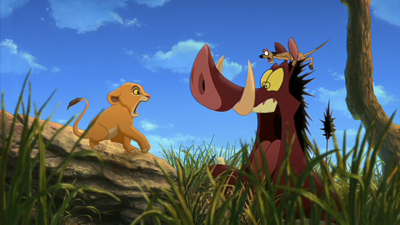
In The Lion King 1½, the “untold tale” of how Simba’s sidekicks Timon and Pumbaa unexpectedly – and unknowingly – influenced the original film is finally revealed! Rewinding way back “before the beginning”, we are taken to Timon’s homeland, where the young pre-Pumbaa meerkat feels left out of his colony. Timon dreams of living the high life – something he gets to do when he fails to report a hyena attack and decides to set out on his own rather than face inevitable scorn. Soon finding himself lost, Timon literally bumps into Pumbaa, the rather confused warthog, and the pair quickly strikes up a bond while, back up on Pride Rock, little Simba’s story is just about to begin…
The Sweatbox Review:
The Lion King II: Simba’s Pride, the made for video sequel that first premiered in 1998, four years after The Lion King’s phenomenal theatrical debut, has a lot to answer for. Disney had pioneered the “video premiere” market prior to the return of Simba and company with the first such officially released title, a sequel of sorts to Aladdin, The Return Of Jafar, which was merely the first few episodes of the spin-off television show strung together and slapped out as a “movie” (with all the inherent sub-standard TV animation to boot). In fact, Jafar, while seen as the first in this line, only really followed what Walt had been doing for years on the Disneyland TV show, animating new sequences to bridge cartoon compilations, and that the company itself had been doing all through the 80s (remember the likes of Goin’ Quackers, Sport Goofy and various Mickey-themed collections?) on home video.
There were several other titles put out around Jafar’s release too: “movie” outings for the Gargoyles and the Mighty Ducks – all Disney TV releases – flooded the market, providing filler for the home video crowd before a given show began its television run. Into this fray stepped The Lion King II: Simba’s Pride, which can now really be seen as the true launch of the direct-to-video premieres. This was no TV show, or string of shoddy episode groupings (leave that to Timon And Pumbaa’s spin off). Instead, Disney set up a studio especially to create it, and it was planned and animated in the style of the original film – then the biggest grossing animated film of all time – and with a singular storyline in place of a generally episodic, compilation nature.
The idea behind Simba’s Pride was to craft a sequel, Aladdin-style and on a much lower budget, though as close to feature film quality as these constraints would allow. Characters had been designed, the story set up and voices cast from the previous film, meaning a much less production lead time and cost (the actors would return for scale too, seeing that this was not going to be as “big” a movie). The result was a film that surprised many, not least in the amount of home video units the title shifted, which crept into numbers usually reserved for theatrical releases. Simba’s Pride became one of the first Limited Issue Disney titles put out on DVD, standing next to such classics as Peter Pan, 101 Dalmatians, Pinocchio and the then-recent Mulan, outselling most and cementing the Lion King brand as a major Disney franchise.
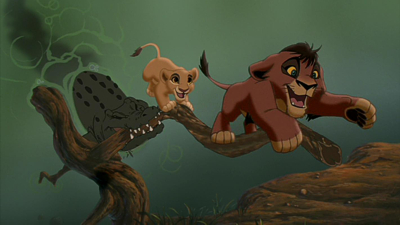
Not only was Simba’s Pride one of the earliest DVD features that helped establish the format, but its success also unleashed the idea of more direct-to-video sequels. While no one was particularly against the studio creating follow-ups to its recent theatrical hits (after all, what studio nowadays doesn’t?), fans were against announcements for films that would sequalize many of those original Limited Issue titles. In the following years, the catalog of home video sequels got to be a ridiculous joke, with many Disney die-hards re-branding them as “cheapquels” – low-budget, low-aspiration attempts to simply cash in. While that underlying fact may be true (the tipping point seemed to be a spot-on pastiche by the Saturday Night Live team), some of these films do stand up, and are still the work of many talented artists who no doubt strove to produce decent quality under the tighter than tight conditions.
Looking back, it’s now easy to see that the titles that came from Walt Disney Television Animation are pretty risible and barely conceal the attempts to hang three or four episodes on a bookended storyline. But at the eventually named DisneyToon Studios, based in Australia, became better and better at churning out the goods. Originally two studios, with a satellite based in Canada, the Canadian studio was shut down during production of Return To Never-Land, with the remainder of that film, and subsequent DTVs created down under. However, setting up this practice, and one of the few films to actually be completed in Canada, was Lion King II: Simba’s Pride. Though not made directly by the original artists, Simba’s Pride was created with the big screen in mind, being framed for widescreen and even getting limited theatrical releases in select cities and some international countries. So, looking back on it some almost 15 years on, and coming hot on the heels of its predecessor’s surprisingly successful recent reissue, how does it compare?
Pretty well, actually, although if the story sounds strangely familiar it’s that, in the end – and as with many of these DTV offerings – the story is merely the child of the original protagonist in a reversal of the original storyline, and little more. However, and as such, the film just about holds up under that thin premise. There is an unwritten “rule” than the Lion King films all follow Shakespearian themes, with the 1994 original loosely following the plot and events of Hamlet, and the next film, Lion King 1½, being Timon and Pumbaa’s take on Rosencratz And Guilderstern Are Dead. If this is so, then there’s an argument that Simba’s Pride is Romeo And Juliet dressed up in lion’s clothing, the plot of two young lovers from opposing families somewhat backing this up, though obviously without the tortuous affair and death!
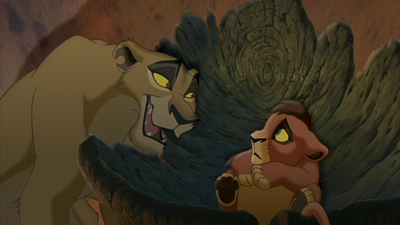
Of course, that may be hyping things up a little too much, for Lion King II isn’t honestly as layered as either the original or even the Timon and Pumbaa re-match, being much more workmanlike and plodding in its structure (plus there’s that excruciatingly bad lift of the final “thwack” from the original film’s Circle Of Life to hit on the main title – something I was hoping they’d fixed here). This rather lack-lustre approach extends somewhat to other areas of the film too, with performances being fine but not outstanding, despite the return of most of the cast (though as with all other Lion King projects, Zazu’s Rowan Atkinson fails to show up again, meaning that Timon and Pumbaa get more stage space). Perhaps it’s something in the voice direction, but there doesn’t seem to be the immediacy that the original readings brought to the script, which covers all bases without providing any stand-out moments of its own.
Sounding much more mature is Matthew Broderick’s Simba, though this could be simply because his role now is protective parent, and though he often seems like the playful but serious Simba we know from the original, his spoken lines are pretty lightweight, being explanatory in the extreme (though again, I guess this is Kiara’s story). Joining the pride are newcomers Neve Campbell as the grown up Kiara (sung by Liz Callaway – Jasmine’s singing voice in the Aladdin sequels as well as singing stand-in for Meg Ryan on Anastasia), Andy Dick, who being as annoying as the Nuku character is in the film, suits just perfectly, and Jason Marsden as Kovu, a long-time animated vocalist who here puts his all into the role, but comes off sounding a little “forced” in the big dramatic moments. Marking a return to the Disney fold is the now-late Suzanne Pleshette, star with Dean Jones in a number of classic live-action comedies for the Studio, and here playing against type as Zira, the villainess of the piece, quickly putting those previous outings out of mind with her wicked take on the character.
Nathan Lane and Ernie Sabella turn up again and run off their lines with customary vigor (providing the better half of the laughs through their performances alone), while I’m not sure why James Earl Jones was needed: his Mufasa’s lines are severely limited, being not much more than grabs from the original. Rounding out the cast is Robert Guillaume, who here seems to have lost his hold on Rafiki and plays him straight as an old fool rather than the mystical eccentric that we loved in the first film. The slightly “off” nature of the film continues throughout the rest of the soundtrack, never really becoming truly enveloping. The savannah doesn’t have the richness of sound that the first had, with ambience sounding a little like an afterthought rather than the full, surrounding sound of Africa that The Lion King suggested and achieved.
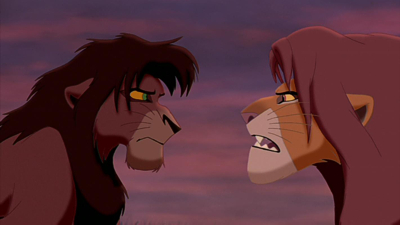
The songs are also a mixed bag. Very often, it’s easy to write a nice-sounding theme and run off a half-decent song that will please fans and fill the gap needed, and the video sequels had an infamous habit of doing this, so long as they sounded typically “Disney”. It’s not unusual for melodies and lyrics in the bigger films to go through multiple re-writes, more re-writes and re-writes again until the perfect blend is reached, something that these films seem to lack, however finely produced they may sound. The opener, He Lives In You, comes straight from the theatrical stage show, and is a belter in that production, landing right in the middle of the story. Using it here (as sung by original Lion King contributor Lebo M) is a corking set up, though it doesn’t help that the similarity to the Circle Of Life sequence kicks things off with those clear comparisons in mind. Disappointingly, Tina Turner’s rendition of the track, played over the closing credits of the European version, lent the film another layer of star billing and power that seems missing here (but see below for a pleasant audio surprise).
Of the other songs, Simba’s We Are One (putting into verse what Mufasa explained to Simba in the first film) and Love Will Find A Way are pleasant enough, even if they are not Disney classics. I couldn’t shake the feeling that, for some reason, We Are One (performed by, among others, LadySmith Black Mambazo, who gained a reputation following their work on Paul Simon’s Graceland album) has a very Irish jaunty touch about it, but maybe that’s just me! Zira’s Be Prepared knock-off My Lullaby comes off worse, due to an empty production and trite lyrics (co-written by Buffy The Vampire Slayer and Titan AE screenwriter Joss Whedon) and Upendi feels like a way too obvious filler for Hakuna Matata, being a very laid back Jamaican tune that doesn’t fit in well with the momentum of the film at where it has been placed.
The same criticism could be levelled at Love Will Find A Way, a song that says the same things as If I Never Knew You from Pocahontas and is placed in about the same spot as that song was intended, the difference being that those characters really did build up a relationship in the film as opposed to the love-struck teenagers here who warble along just as the climax is cranking up and ready to roll. Admittedly, the song is among the best of the bunch, or is that just because it seems so familiar, as if it had been cobbled together from various other, similar themes? Nick Glennie-Smith’s “new agey” score plays along inoffensively throughout, but none of the musical contributions match the tight John/Rice/Zimmer team from the first film with a result that feels like a high-school production trying to mount the same heights as its predecessor, and a more “cod-African” style than even the first film.

Likewise the animation feels a little skimped on in places. There is some fine stuff in here to be sure (usually when fast action dictates full 24 frame movement), and Simba’s Pride absolutely marked a step up from the lower-quality episodic nature of the previous DTV titles such as the Aladdin sequels. Simba’s Pride, also as with most of the work that came from the Canadian studio and then Australia, finds a comfortable “middle-ground”, being a vast improvement over TV fare, but not quite as in the same league as Feature Animation or even as good as the DisneyToon-ers would get by the time of their Bambi and Tarzan sequels. What doesn’t help is that the film has the unfortunate accident of following one of the most well animated and detailed features from Disney’s – namely the original Lion King! – which had such a deep, warmer look due to the emerging CGI capabilities to add in background detail and character tones (lighting and shading).
Lion King II attempts such niceties, but there is a noticeably much “rougher” quality about it. Character faces don’t have any of the subtleties that peppered the original film, and some shots are striking for all the wrong reasons, as background cast members who remain static and devoid of all life, and some close ups that appear ham fisted and awkward. The drawing is mostly all carried out on twos, with thicker character lines for the most part, even though they are individually colored and lip-sync is mostly better than expected. Designs are fairly bland, with Kiara not that different looking from young Nala in the first, and there’s also a very predictable take on the villains too, them being more mangy and baggy-eyed than their “well off” Pride Land counterparts. Despite what can only have been a heartfelt attempt to create a lasting sequel to one of Disney’s most popular films, I never really quite worked out why the studio didn’t go all out and produce a fully-fledged sequel to The Lion King. Could it be that, although they had previously released a theatrical follow-up (and counted in the main canon of “classics”), The Rescuers Down Under, that Studio execs really knew in their heart of hearts that Disney is all about telling new stories, or new twists on traditional themes?

It seemed to me, watching Simba’s Pride again after only seeing it a couple of times (on its original 1998 release and a previous DVD Special Edition), that there isn’t a lot worth getting too worked up about. The film plays through without much incident, not being terribly exciting or grand, though there are moments when things gel and a deeper, more layered story peeks through. There are some nice things that further suggest this, especially the new names: Kovu is highly appropriate, being Swahili for Scar, while Zira means “hate” and Nuku represents a “bad smell”. However, on the flip side, Vitani’s character name, at one point Shetani, meaning “devil” in Kiswahili, was changed for something less offensive and it’s this dumbing down to kid audiences that really doesn’t help the film rise above its game.
As is normal for an animated film, a large team of screenwriters get on-screen credit, but could it be this time around that the project was being stretched in too many directions, trying to be its own film, while staying too closely tied to the original? Sometimes overwhelming success can overshadow any attempts to live up to it, and that seems to be the underlying difficulty here, as the resulting film isn’t anywhere near bold enough as it should be to carry it off (unlike Lion King 1½, which succeeds simply by going totally off in the other direction). Some plot points disappear into holes too, such as what happened to Simba’s mother – are we to assume she has now joined Mufasa in the stars in the sky?
Certainly, the choices of Darrell Rooney and Rob LaDuca as co-directors seems odd; the pair previous to this had not really been involved in anything other than a clutch of television specials until this point. Both would go on to helm other DTVs (LaDuca on DreamWorks’ abysmal Joseph: King Of Dreams) and Rooney did actually build on what he obviously learnt here with the charming Lady And The Tramp II: Scamp’s Adventure before the ill-fated Circle 7 Animation debacle had him in the director’s chair for a time on Disney’s then Pixar-less Toy Story 3.
While not as majestic as the original, nor as funny as the “side-quel” take on events, the marketing will have those who enjoyed both films completing their circle of life and adding Simba’s Pride to their collections. To be fair, it stands up against an impossible to top original pretty well, though admits defeat to the law of diminishing returns, at least artistically. With nothing too outstanding to shout about, nor anything too objectionable to warrant complaint, The Lion King II: Simba’s Pride is about on par with the better DTVs and plains ahead of the worst of that bunch, being worthy of a look. It also nudges its score just over a mark from six to seven for being a reasonable length, rather than the one-hour TV-friendly running time the recent DTVs have come in at.
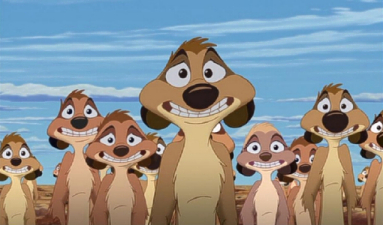
The Lion King 1½ (aka The Lion King 3: Hakuna Matata internationally, for some reason) conversely had Disney’s direct-to-video movie sequels coming of age. Not so much the kind of “mid-quel” that Beauty And The Beast’s Enchanted Christmas was, but more of an “inter-quel”, Lion King 1½ comes not between parts one and two, nor even in the middle of the original film, but actually playing “alongside” it, Back To The Future Part II style or, to pick on some more recent also-quels, along the lines of DisneyToon Studio’s own Cinderella III or DreamWorks’ reset-switch setting Shrek 4. Kind of. Because The Lion King 1½ is also unlike any animated film you’re likely to have seen before or since. We kick off as usual, expecting the 1994 blockbuster to play through as normal, though it is soon halted and spun around by Timon and Pumbaa, who decide to show us, the audience, their side of the story, and how things “really” happened.
Disney’s DTVs came full circle (of life?) with this release, as it could arguably be said that the whole direct-to-video niche that the Studio created started with the issue of Lion King II: Simba’s Pride to video and DVD (remember that their previous release, The Return Of Jafar was composed of the first five episodes of the Aladdin spin-off TV show, and Simba’s Pride was designed as a full feature and with video in mind from the start). Now, with The Lion King rearing its head again and having its roar heard through the phenomenal theatrical reissue and recent Diamond Edition Blu-ray release, it’s quite possible that there has never been a better time to revisit The Lion King 1½’s unique brand of pastiche, even if you saw it first time around, or to catch it for the first time, which is surely how some younger new fans of the original film will come to it.
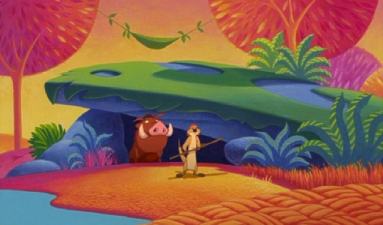
Actually, and although the film does contain some of the best animation to come from the Australian DisneyToon group, it was a touch of the “cheapquels” that was mostly in danger of annoying me with this release…that the whole endeavour, from the outset, appears to be little more than the original film run through with an “optional visual commentary”, like some early DVDs took great pride in promoting before the technology fell by the wayside (just as Blu-ray’s much hyped interactivity seems to have done), added to the film. Yes, Mystery Science Theater 3000 did it first, poking fun at ancient sci-fi flicks with on screen jibes, but going back even further is Tom Stoppard’s play Rosencrantz And Guildenstern Are Dead, which looks at the events of Shakespeare’s Hamlet from the sidelines of two supporting characters (clearly cementing the notion of the Bard’s influence after The Lion King’s many parallels to that story and the second film’s Romeo And Juliet rehash).
Attacking this perhaps overly obvious concept may be a little harsh however – once the movie begins, it’s soon apparent that there is, in fact, some fine work going on, from the writers, animators and voice cast, but perhaps the only thing holding this back from working as a fully fledged theatrical feature is that it just doesn’t feature that much of its own story. In truth, what we do get is a funny, observant and enjoyable journey through the events of The Lion King, as seen from the viewpoints of its two supporting characters and eventual break-out stars, Timon and Pumbaa, the meerkat and warthog double-act that also went on to enjoy success as travel guides in the video compilation Around The World With… and their own television spin-off.
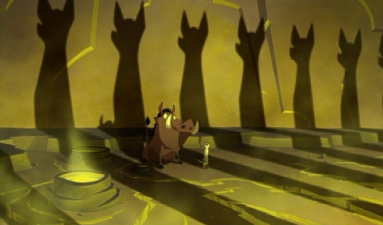
As the pair fumble their way through various landmark scenes from The Lion King, and actually instigate others, what becomes fundamentally apparent is that first time viewers simply must have seen the original film before they embark on this new update, or else many of the jokes will fall flat, and in many cases the story just won’t make sense! The more familiar one is with the film really does help in understanding the new takes on events, and especially those huge fans of The Lion King that saw it again very recently and have refreshed their memories will have perhaps the best time of all. There’s really no point springing for this one if you’re a Lion King newbie – since 1½ centers so strongly on spoofing scenes from the original movie that it would be like being the outsider in a very private joke. Those who get the joke, though, will have a blast!
The start-stop technique (Timon is prone to pausing the movie with his remote) is ever so slightly irritating, but it is usually to fit yet another joke in, and as such, just about works. As narrated by Timon, The Lion King 1½ plays out in much the same way as a Zucker Brothers’ spoof (think Airplane, Top Secret or the more recent Scary Movie sequels), where the recognition of the scene accounts for much of the humor. Throw in many pop-culture references (one scene plays out to Ennio Morricone’s immortal The Good, The Bad And The Ugly theme) and you’ll get a pretty good idea of the direction and tone the film takes – though it’s a testament to how well the original Lion King was constructed that it supports this wide and wild take on it. Even the amusing moments we have come to know well from the 1994 film still feel fresh and funny, while also providing a new spin on several sequences (Can You Feel The Love Tonight, particularly, works very well in this example).
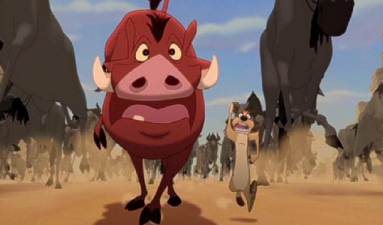
The animation is also very strong and easily remains the Australian studio’s topping achievement, being extremely well blended in with shots and elements from the original, and providing several nice touches throughout the film – some that only eagle-eyed watchers will notice. One such shot that raised a laugh comes right after Timon and Pumbaa get a night’s sleep in a nearby cave, and are awoken next morning by Simba’s belting out the Just Can’t Wait To Be King number. As the meerkat emerges from the cave to complain, we see that the entire background has morphed into the highly stylised look of that sequence from the original!
When it comes to the new songs in Lion king 1½, they work rather effectively, given the kind of direction the production takes, and at times do recall the original film in more ways than one (hints of Can’t Wait To Be King again in Timon’s “I want” moment, based on Warthog Rhapsody, a song written for, but replaced by Hakuna Matata, in the original film). The vocals, largely featuring the first film’s original voice cast, don’t sound a pitch different than how we remember them, though it is again a shame that Rowan Atkinson chose not to participate in either this film, the video sequel nor the Imax Special Edition of the original’s new Morning Report number, since the replacement Zazu just doesn’t quite hit the right tonal marks.
Returning as Timon is Nathan Lane, aided and abetted by Ernie Sabella as Pumbaa. Joining them for this wacky outing are most notably Julie Kavner (better known as Marge Simpson) as Timon’s mother, and Jerry Stiller (father of Ben) as the meerkat’s uncle, who contribute a wealth of animation voice experience to their roles and help the rather dry dialogue lift off the page. The best lines, of course, go to Timon, the sarcastic meerkat with an answer for anything, and a unique way of putting things. It seems nothing from the original is sacred to either Timon, nor the filmmakers, who quite happily place the most irreverent dialogue into his mouth, whether he’s just being flippant, or speaking about one of the first film’s most revered moments – or both at the same time!
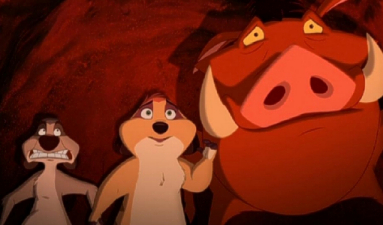
In fact, the film seems to take the more “hokey” elements of the original – as well this new film – and goes about sending them up in any way imaginable before the critics and nay-sayers can have a go. But somehow it all seems to work. The Lion King 1½ also has its own story, and surprisingly a lot of heart, though if the film does have a fault, it’s the lack of an strong emotional core – everything is played for broad laughs – and even if we know the outcome of the story, this new version perhaps needs a more suspenseful ending – though the one provided is strangely satisfactory and doesn’t outstay its welcome.
Ultimately, we end up at the right place: friendships are confirmed, family reunited, and events rounded off in the now customary Disney way, though with much more sardonic wit and self-referencing than is usual from the Mouse House. So much so, if truth be told, that I did wonder whether it was because the Studio was so at ease at toying with their biggest traditional animated franchise, or whether the whole endeavour smacked of sheer desperation in trying to keep up with the then-popular Shrek attitude and the new trend of having to be one jump ahead of the audience by throwing them curve balls and tilting them just off balance enough so as to appear “new and exciting”.
The Studio had been in this territory before, of course, with The Emperor’s New Groove and the eventually disappointing Chicken Little, but there’s still never really been anything quite like The Lion King 1½ from Disney; not something like this that really pushes the boat out, breaks the rules and pokes fun at itself with such bite. Not nearly anywhere as masterful as the original film – but then again not at all intended to be! – it does however stand tall above Simba’s Pride as a companion piece and as a comparison to how confident the DisneyToon crew became between the two films’ production. Still surprisingly well-crafted and very, very funny, if anything the current vogue for spoofery should help The Lion King 1½ find an even bigger audience, and deservedly so!
Is This Thing Loaded?
Taking their cues from their original Special Edition DVD releases, both The Lion King II and The Lion King 1½ retain and drop elements from those previous discs in order to host their respective movies and extras on one Blu-ray disc each (both titles are sold separately). Included in both packs is a regular DVD that also contains a couple of token supplements, as well as the usual collection of Sneak Peeks which, across all discs in both titles, include previews for Disney’s All-Access online concept, Cinderella’s Diamond Edition, Disneynature’s Chimpanzee, The Lion King on stage, the Disney Parks, Finding Nemo on Blu-ray, Treasure Buddies, Secret Of The Wings and the Movie Rewards program.
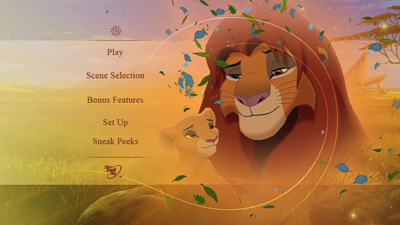
The Lion King II’s line up of supplements on DVD wasn’t the most filling plate of grubs, but here the skimpy selection seems a bit more palatable than before, when the promise of a second DVD suggested a whole lot more. Featuring menus that mirror the recent Diamond Edition for the first film, new to this release is Timon & Pumbaa’s Insectapedia (5:30 in HD), although it’s nothing to get excited about, especially since Timon is voiced not by Nathan Lane, but by the passable sound-alike that often stands in for him on these kinds of things. Ernie Sabella returns as Pumbaa, but Lane clearly doesn’t really need the work, and although his vocal impersonator isn’t too bad as it goes, he’s still not quite right, and I was surprised that the warthog wasn’t given more lines, considering. That said, this is an okay primer on real-life insects for the young’uns, with archive footage blended in to the night sky background in which the stars outline the next creature (and, don’t worry: I didn’t spot any SFX attempts, wink-wink!).

The rest of Lion King II’s supplements have been ported over from its previous Special Edition DVD, listed as Classic DVD Bonus Features. We lose the main feature’s fact-based text Trivia Track, Timon And Pumbaa’s Virtual Safari, much-heralded at the time, a couple of Pride Land Games and the not-so-missed three-minute Lots About Lions information clip, but thankfully kept is the single reason for many die-hard Disney fans to pick up the disc alone – the inclusion of the One By One animated short. As with the eventually released Destino (and the still to be released Lorenzo), One By One was intended as one part of a possible third Fantasia feature, before that project then changed into being something more original, with new music to accompany the visuals.
Scored by The Lion King’s Lebo M (actually taken, as with Turner’s performance of He Lives In You, from the Rhythm Of The Pride Lands “soundtrack sequel” to The Lion King), and produced by that film’s Don Hahn, One By One and those other titles seem destined to live only as stand-alone shorts, especially with Roy Disney’s passing and the cancellation of the announced Fantasia World compilation in those films’ Blu-ray debut. Though early reports had Hahn listed as the director of the short, it was actually been helmed by Pixote Hunt and David Bossert, who both contributed to Fantasia 2000 (Bossert was also a long serving producer of the extras for the Walt Disney Treasures line).

Although you’ll be pleased to know that One By One is presented just as it should be, complete and intact in a digital 1.66:1 widescreen transfer, it’s a crying shame that it still only appears in standard definition and not HD, even if the near-maximum bitrate for DVD encoding keeps the compression up above 8.5mbs for the most part. The five and a half minute film follows the travels, Forrest Gump-style, of a single brightly coloured feather as it floats and comes to rest in the hands of a young African boy, whose impression of a newspaper blown up against the remains of a wire fence give him and his friends the idea for some very colourful kites. What remains incredibly striking about the film is the quality of animation, by the Feature Animation crew and featuring what are certainly Deep Canvas techniques, light years ahead of Simba’s Pride itself and easily of the level that other potential Fantasia spin-off segments have been.

The lack of a main title (it comes at the end) and Foley sound effects also indicates that this was intended as sequence for an instrumentally scored picture, but this is frankly all for the good, as it means we can appreciate more the perfect blend between the clean soundtrack and absolutely beautiful artwork. With an infectious youthful spirit and buckets of gentle fun, the short remains one of the best gems to come from the Studio in recent years, and it’s still somewhat of a shame that it has been dumped directly to a home video release when it deserved so much more (such as an Oscar nomination). The traditional, hand-drawn animation literally sparkles, and is the richest looking I have seen from Disney in a long while, even given their more recent return to the form. Never outstaying its welcome, One By One is a pure delight, with amazingly animated details, and is eminently re-watchable.

Timon & Pumbaa’s Find Out Why (7:35 in a Play All option) re-plays the series of shorts in which questions are answered by the meerkat and the warthog using footage sponsored by the National Science Foundation. Well animated – and using a variety of styles and mixed media – these funny clips (running around 90 seconds each) build on the scene in which Timon explains the mystery of stars (“fireflies stuck all over that big darkish blue thing”) from the first film. Here, he gives similar, wacky answers to such questions as why there is thunder and lightning, why we sneeze, why pandas live in the desert, why there is wind, and why an airplane flies, while Pumbaa – as usual – displays slightly more logical and scientific reasoning. Good shorts, with Sabella and Lane back as the characters, and a reminder of the 1980s educational films that Disney produced, showing that they can easily help kids understand a subject, even when those kids think they’re being entertained!
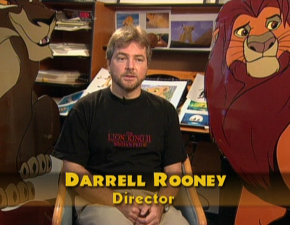
A token “making of” featurette, Proud Of Simba’s Pride is some EPK-styled coverage of the production that runs a barely minimum seven minutes. It covers all the bases in rudimentary fashion, with soundbites from director Rooney, who tries to explain the emotional roots, and the cast, but with all the gushing go on (Suzanne Pleshette describes the film as “wonderful…I loved it”, while the rather annoying Jason Marsden agrees, saying “I love it, love it, love it”) you’d wonder if they’d actually seen Simba’s Pride at the time they made their remarks. Certainly they’re all captured at the time of recording their lines, so their comments are all based on what they think the movie will turn out like, though the funniest part is seeing executive Sharon Morrill trying to justify the project: “The Lion King is probably the most successful animated feature of all time, and we felt that in order to satisfy our audience’s craving for more and to have them be able to spend more time with the characters, we created a sequel for them”. Nice…thanks for that.
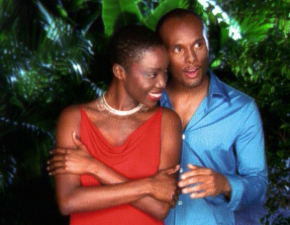
Finally – yes, really – and while not containing much replay value, Heather Headley – spectacular as Nala in the Broadway production of The Lion King and as the title character in Disney’s Aida stage musical – sings with Kenny Lattimore on the closing credit “pop version” of the ballad duet, here included as a Love Will Find A Way music video clip. Shown in original 4:3 full-frame, it’s a pretty standard and generic promo for a pretty standard and generic song. Headley has an amazingly powerful voice, though the song doesn’t really do it justice, never rising above the tame chorus and sounding pretty drab. Lattimore is hysterical trying to give off his sultry looks and the fact that the pedestrian lyrics don’t introduce anything new doesn’t help the bore factor. A much better choice would have been a clip for Tina Turner’s much more powerful He Lives In You (check the audio section below), though that this lasts four and a half minutes is at least better than the usual 30-second promo for whatever soundtrack Disney is pushing at the time.
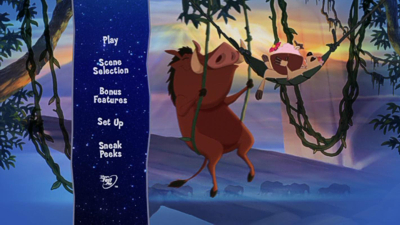
The Lion King 1½ pretty much follows suit, jettisoning some of the more frivolous stuff (a Hidden Mickey feature, the return of Timon & Pumbaa’s Virtual Safari, and several set-top diversions including a Who Wants To Be A Millionaire joke game) and retaining only a handful of supplements. Those hoping for some of the Virtual Safari material to remain intact will be disappointed by Timon & Pumbaa’s Vacation Safari (4:57 in HD), which basically replays the ideas behind the Insectapedia, but instead of bugs it this time shines the light on the animals to be found around the Pride Lands, again hosted by Sabella and his sound-alikey pal. Featuring only the barest of minimal “animation”, there’s also only the barest of logical, informative facts given over as well, making this an easy miss.
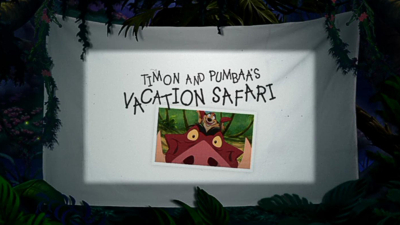
Under the ol’ Classic DVD Bonus Features banner, there’s a Deleted Scenes section, presented in standard definition 4:3, and featuring around 12-minutes worth of scrapped storyboard footage, including two alternate openings (introduced, and with commentary from, director Bradley Raymond and producer George Mendoza), although there isn’t anything of any great note, and in all honesty even these short clips actually start to get more than a little tedious, hence their rightful removal. Just as disposable is the Raven-performed Grazin’ In The Grass music video, which actually feels embarrassingly dated, even if some may find the tune a funky diversion, and again at least it’s longer than Disney’s usual 30-second “music videos”, lasting over three minutes.
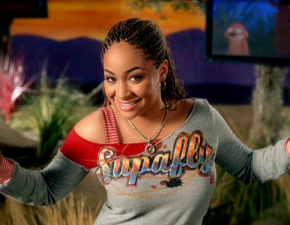
More fun is the Peter (original Mission: Impossible) Graves hosted Timon: Behind The Legend featurette, featuring the “true” story of one of our lead characters. With input from Timon himself (voiced, this time, by Nathan Lane, but animated in the lower-cost TV animation style), this is a funny little aside. In its four minutes there’s nothing of any real substance, but it’s a silly addition, and features one absolutely hysterical and well-timed gag centered on the meerkat’s face. I’m not sure which one is scarier though: Timon himself, or trying to guess how many facelifts and Botox injections the now late Graves might have endured over the years.
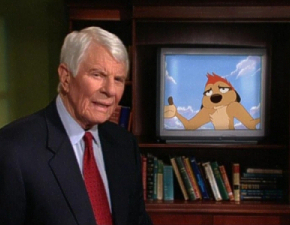
Wrapping up the supplements (yes, again, really) is the Before The Beginning: The Making Of The Lion King 1½ featurette, although it’s a more than generous 15-minute peek behind the scenes. Focusing nicely between the crewmembers and the voice cast, everyone gets to say how great it all was returning to the characters and building around the existing story to create the new film in standard documentary fluff-piece form, but on the flipside it is always nice to see the talent behind the camera, even if, in this case, it does seem to be stuck behind a soft-focus lens covered with copious amounts of Vaseline!
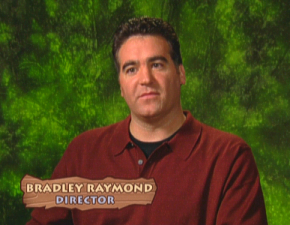
Included on both sets is the now-standard Disney BD plug for Discover Blu-ray 3D With Timon & Pumbaa, which I usually pass over as being nothing more than promo guff but at least warrants a mention here (the bundled-in DVDs contain nothing of worth). All in all, these aren’t bad little packages for each film, but they remain extremely lightweight on the really meaty goods. Of all the Lion King releases, I would have expected one of them to carry Steve Moore’s hilarious 1995 Timon and Pumbaa short Stand By Me, which has the duo singing Ben E. King’s classic song, or maybe the similar The Lion Sleeps Tonight clip from their television show – they really should have made these.
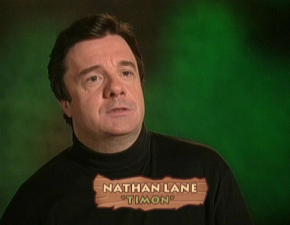
Alas, there’s nothing of that nature to find here, and further adding to the grief is that several intriguing deleted scenes from Simba’s Pride, which are known to exist and have in fact shown up online in storyboard and pencil test form before now, are also nowhere to be seen. Why these were not added to the package is beyond me: it would have absolutely beefed up the offerings and backed up the film, since they would have been a more than viable document of production, and did include some very interesting changes. There was also a European theatrical trailer, which was on the original Limited Issue release and might have given even more, theatrical-level validity to the project, but that too has failed to show up again. A real shame and a very missed opportunity on all counts.
Case Study:
With Disney’s vogue for their recent “2-Movie Collection” titles picking up steam with further titles announced for later this year, it’s somewhat of a surprise that these Lion King sequels haven’t come to Blu-ray Disc in that same way. But then again, both films do stand up in a way some of the lesser films in those double-feature sets don’t, and the House of Mouse knows they’ll make twice the cash given two releases instead of one. This also has the advantage, for collectors, as to how they line up the trilogy on their shelves, since although The Lion King 2 was released first, the packaging here suggests fans can “complete your family’s collection” with the sequel, presumably inserting Timon and Pumbaa’s alternate version of the first film into the middle (something Disney’s refusal to list copyright dates on their packaging makes easy to do).
But, if you’re like me and you think throwing an out and out comedy spoof into the middle of an otherwise dramatic storyline would lead to a serious change of disrupting tone and play down the good elements of the second film, then you’ll line them up in release date order, with Simba’s Pride (1988) coming after the original film, and The Lion King 1½ (2004) bringing up the rear. This also makes for a much more satisfying viewing chronology, too, with Lion King II being a direct continuation from the first film, and the third movie reflecting most trilogy arcs by returning – quite literally in this case – to the themes and elements of part one. Besides, the movie is plainly called Lion King 3: Hakuna Matata around the world, so that pretty much tells you all you need to know anyway.
Whatever the intention, and however you store them, both packs match up precisely, being Disney’s regular BD packages of Blu-ray and DVD discs (no digital copies this time around) in a slimline case and a deluxe slipcover outer coating. Inside there’s not much to get excited about (just a Movie Rewards code insert), and Lion King II has still been inappropriately referred to as “2” throughout, but everything else is all in order and should line up next to whichever edition of the original movie you have on BD nicely (and much more so than the awfully-designed trilogy set that was released last year).
Ink And Paint:
Now here’s an interesting thing: previously released (twice) in the apparently original ratio of 1.66:1, Lion King II here appears in a 16:9 ready 1.78:1 presentation. I thought this might have been a typo on the back of the jacket, but on closer inspection the framing is actually widened on each end of the image. Much of this added info will be cropped by most displays’ overscan function, but it seems this is the first time we’re really seeing the correct ratio for this title. Even so, some of the framing is tight top and bottom on occasion, but the bold images match previous Lion King incarnations on disc. As with the other two films, Lion King II’s color palette is very much based in rich reds, which can be a real headache for video rendering but that seems to present no problems whatsoever for the HD format; the color never bleeds or becomes over saturated. Dark blues – the kind of shade only Disney can seem to find the right combination of – look fantastic and are among the only moments in the film that really pulls one into the artwork.
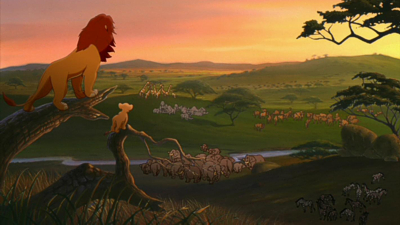
Conversely, The Lion King 1½’s image remains exactly the same, sticking with the original DVD’s 1.66:1 presentation and matching the original movie’s screen dimensions with which it shares some scenes. In fact, I would go so far as to say that this transfer – if it isn’t exactly the same one as before – clearly uses the same source, albeit now bumped up to hi-def levels of resolution. But with simply terrific, feature-matching animation production values to start with, The Lion King 1½ in HD looks even better than I was expecting, and easily as clean and sharp as the original movie. There’s really not much else to say, and though I could waffle on about locked colors and sharp edges, the best way to put it is this: if you were happy with the restoration for the original Lion King’s recent Diamond Edition issue (in 3D or without the added D), then you’ll be more than happy with this: it’s simply a top-notch and very vibrant transfer for a unique addition to the Disney line up.
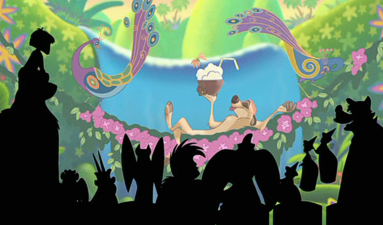
Scratch Tracks:
As was the norm with Disney’s DTV titles, the original DVDs often presented both Dolby and pumped up DTS tracks. With DTS quickly becoming the de facto standard for Blu-ray, it’s essentially that same 5.1 track we get here for Lion King II, albeit in a lossless Master Audio format that opens things up ever so slightly, but it’s still nowhere near as rich and full an aural experience as the original Lion King or even the enjoyable feature-quality track that Lion King 1½ sports. My complaints with the actual soundtrack’s richness are noted above, though what is here is presented as intended. Vocals are clear, music is clean and the surrounds get a little workout from the score as and when it kicks in. Nothing exemplary, much like the film, but perfectly adequate nonetheless.
The Lion King 1½, again repeating the 5.1 DTS track from its original DVD in Master Audio format, easily bests Lion King II’s mix, and comes close to aping The Lion King’s all-enveloping track on that film’s recent BD release. Sounding more “punchier” than most of the Disney DTVs, it’s certainly an aggressive mix for an outrageous movie (and central performances from Lane and Sabella). Dialogue is locked to the center, while the rears feature the surprisingly rich atmospherics, directional effects, and the odd activation on big music cues or action sequences. A good, fun, strong track; everything here, like the film itself, is pushed to the limit!
On both discs, French and Spanish dubs (in Dolby 5.1) and subs are offered across the Blu-ray and DVDs, but one highlight to listen out for on the Lion King II: Simba’s Pride disc, while not exactly an Easter Egg, is a “hidden” extra – the Tina Turner version of He Lives In You, present and correct on the French-language track, replacing the end credit score music with a much more powerful version of the song, which was featured on European editions. A very cool find, this option on the credits also supplants the rather drab Love Will Find A Way with a much more bouncy version of Upendi, ending the film on much more of a powerful and upbeat note!
Final Cut:
Simba’s Pride is an adequate entry into the series, but one that seems a little redundant these few years on. A good deal of work went into the production, and there’s no doubting fans will get a lot out of it, but casual viewers may experience extreme déjà vu in the plot, and older siblings and parents may find sitting through it multiple times may not be as rewarding as the original or the other, spoofing sequel. A commentary would have been welcome on the disc, while those deleted scenes being a no-show is a case of dropping the ball, as is the lack of the hysterical Stand By Me short.
The included One By One, on the other hand, is an expert combination of traditional character and computer-enhanced background animation that we usually expect from Disney, and could surely make the package worthy of purchase alone for long-time dedicated fans – if they don’t have the original Lion King II Special Edition DVD, since this disc doesn’t bother to upgrade the short to HD. Simba’s Pride has nothing of the roar of the original, but it’s still a moderately entertaining re-tread that should just about please those who need another fix of their animated lions.
As for The Lion King 1½, well yes, one could argue that the very notion of the movie reduces the masterful original to comic mush, but it’s fast, it’s flashy, and downright fun – and so what!? The Lion King 1½ successfully broke the rotten spell and general bias against Disney’s DTV product back in the day and heralded a number of much more artistically merited productions. Timon and Pumbaa return in style, in a comedy tailored directly to the strengths of their characters and vocalists, with Lane and Sabella playing along gamely and having as much fun, it sounds, as the audience. Hakuna Matata!
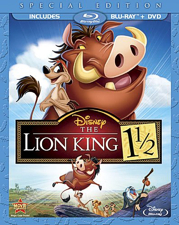 | ||
 |


